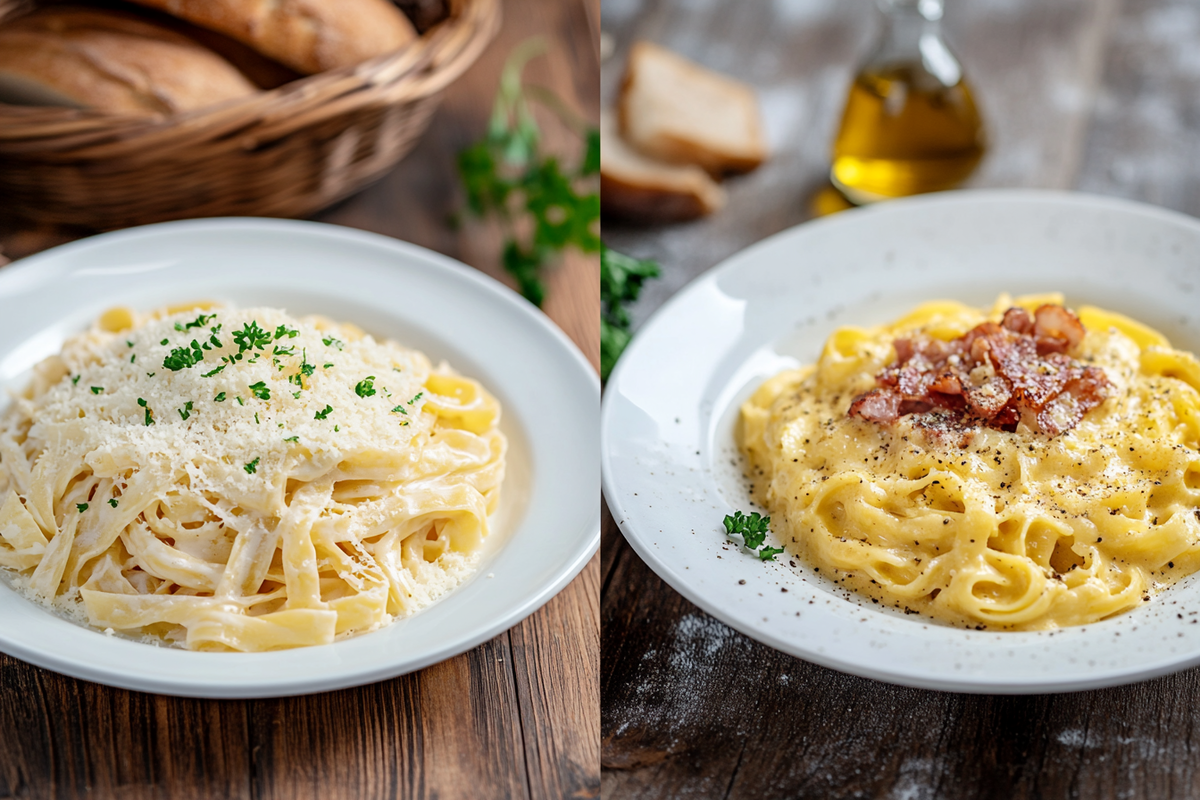When it comes to classic Italian pasta dishes, Fettuccine Alfredo and Fettuccine Carbonara are among the most popular choices. Both are creamy and indulgent, yet they differ significantly in their ingredients, preparation methods, and overall flavor profiles. Understanding these differences can help you make an informed choice between the two, whether you’re cooking at home or dining out.
Understanding the Difference Between These Two Fettuccine Dishes
Origins and History of Fettuccine Alfredo vs. Fettuccine Carbonara
To begin with, Fettuccine Alfredo and Fettuccine Carbonara each have unique origins. Alfredo di Lelio created Fettuccine Alfredo in Rome in the early 20th century. Initially, he made this dish for his pregnant wife using only butter and Parmesan cheese. As it gained popularity, particularly in the United States, chefs began adding heavy cream, which became a hallmark of the American version.
In contrast, the origins of Fettuccine Carbonara can be traced back to the Lazio region of Italy. This dish likely emerged in the mid-20th century, possibly influenced by American soldiers’ rations or Italian coal miners, known as carbonari. The traditional recipe includes eggs, Pecorino Romano cheese, pancetta or guanciale, and black pepper, creating a creamy sauce without the use of cream.
Key Ingredients Compared: Alfredo vs. Carbonara
Recognizing the key ingredients in these two dishes not only enhances your appreciation of Italian cuisine but also helps you choose the right meal based on your preferences. While both dishes are creamy and rich, their distinct ingredients and preparation methods set them apart.
Different Preparation Techniques for Alfredo and Carbonara
To prepare Fettuccine Alfredo:
- First, cook the fettuccine until al dente.
- Then, melt butter in a pan, mixing it with a bit of pasta water to form an emulsion.
- Next, toss the cooked pasta with Parmesan cheese in the pan until the sauce coats the noodles evenly.
- Finally, serve immediately with extra Parmesan and parsley if desired.
To make Fettuccine Carbonara:
- Start by cooking the fettuccine until al dente.
- Next, render the fat from pancetta or guanciale until crispy.
- Whisk eggs and Pecorino Romano together in a bowl.
- After draining the pasta, toss it with the hot fat and meat. Remove from heat, then quickly mix in the egg mixture, using reserved pasta water if needed to achieve a creamy consistency.
- Finally, serve with extra Pecorino Romano and black pepper.
Comparing the Flavor Profiles of Alfredo and Carbonara
Fettuccine Alfredo is known for its rich, creamy, and buttery flavor. The combination of butter and Parmesan cheese creates a mild yet indulgent sauce that coats the fettuccine noodles. This dish is often described as comforting and satisfying, with a smooth texture that pleases the palate.
Fettuccine Carbonara offers a more complex flavor profile. The Pecorino Romano provides a tangy and salty bite, while the pancetta or guanciale adds a smoky and savory element. The eggs contribute to the creamy consistency, and the black pepper adds a touch of spice. The result is a dish with rich, layered flavors.
Nutritional Differences Between Alfredo and Carbonara
Generally, Fettuccine Alfredo has more calories and fat compared to Fettuccine Carbonara. This is primarily due to the use of butter and cream. A typical serving of Alfredo can range from 600 to 1200 calories, depending on portion size and ingredients.
Fettuccine Carbonara is somewhat lower in calories because it does not include cream. Its fat content comes from eggs, cheese, and pancetta, making it slightly lighter while still indulgent.
Pairing Suggestions for Alfredo and Carbonara
Fettuccine Alfredo pairs well with light, crisp salads and white wines like Chardonnay or Pinot Grigio. A simple green salad with a vinaigrette can help balance the richness of the Alfredo sauce. For added protein, consider serving it with shrimp or chicken.
Fettuccine Carbonara is best enjoyed with a side of roasted vegetables or a Caesar salad. It pairs well with full-bodied white wines like Sauvignon Blanc or lighter reds such as Pinot Noir. Garnish with extra Pecorino Romano and black pepper for additional flavor.
FAQs
What can you substitute for pancetta in Carbonara?
If you don’t have pancetta, bacon is a suitable substitute for Carbonara. While bacon has a smoky flavor, it still provides the necessary fat and saltiness. Alternatively, you can use guanciale, though it might be harder to find outside of Italy.
Is Alfredo healthier than Carbonara?
Typically, Carbonara is considered slightly healthier than Fettuccine Alfredo because it doesn’t contain cream and relies on eggs and cheese for richness. However, both dishes are rich and should be consumed in moderation.
Can you make a vegetarian version of Carbonara?
Yes, you can prepare a vegetarian version of Carbonara by omitting the pancetta or guanciale. Substitute with roasted vegetables like mushrooms or asparagus to add flavor, but note that the dish will lose some of its traditional taste.
How do you prevent the eggs from scrambling in Carbonara?
To avoid scrambling the eggs in Carbonara, remove the pan from heat before adding the egg mixture. Toss the pasta continuously to ensure the eggs coat the pasta evenly without cooking too much.
What’s the best pasta type to use if you don’t have fettuccine?
If fettuccine isn’t available, you can use spaghetti or linguine as alternatives for both Alfredo and Carbonara. These pasta types work well with creamy sauces and offer a similar texture and flavor.
Conclusion
Understanding the differences between Fettuccine Alfredo and Fettuccine Carbonara enriches your appreciation of these classic Italian dishes. Whether you prefer the creamy, rich taste of Alfredo or the savory, robust flavor of Carbonara, each dish offers a distinct culinary experience that highlights the diversity of Italian cuisine.
By knowing the key ingredients, preparation methods, and flavor profiles, you can choose the dish that best suits your taste or try making both. Enjoy these pasta dishes with good company, as they are meant to be shared and savored.




